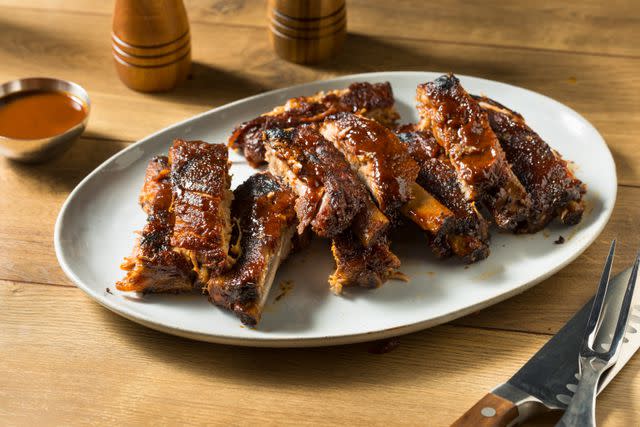Spare Ribs vs. Baby Back Ribs: A Butcher Explains the Difference
You shouldn't cook them the same way.
:max_bytes(150000):strip_icc():format(jpeg)/Simply-Recipes-Baby-Back-vs-Spare-LEAD-01-f25988740ca141578f7fb82f7be87583.jpg)
Simply Recipes / Getty Images
Perhaps made (extra) famous by at least one restaurant jingle, baby back ribs get a lot of love. But spare ribs can be just as tasty. So says Sean Flynn, a former butcher who is now director of sales at Niman Ranch, a network of more than 600 family farms and ranchers raising beef, pork, and lamb.
“You’ll get great flavors from either,” Flynn says. “Back ribs come from the loin section where you get your pork chops. That meat really tends to be very tender and a little bit leaner. Whereas the spare ribs, being closer to the belly, tend to be a little bit fattier and have a lot of flavor.”
The Difference Between Spare Ribs and Baby Back Ribs
Spare ribs and baby back ribs come from the same pork ribs. Baby backs are from the section of the rib cage closest to the backbone, and spare ribs are the extension of those ribs, further away from the backbone.
Baby backs have a rounder shape, while spare ribs—also called St. Louis spare ribs—are flatter and longer. Baby back ribs usually cost a little more at the grocery store than spare ribs.
Barbecue restaurants tend to serve spare ribs most often. “I’ve seen restaurants stack them up like Lincoln Logs,” Flynn says. “They tend to make a beautiful display. For what you pay, the flavor is fantastic.”
Because baby back ribs are leaner, they can dry out more quickly if you cook them too long. Spare ribs offer more of what Flynn calls an insurance policy. You have a little more leeway in how hot and long you can cook them before they dry out.
“I grew up eating baby back ribs and started them low and slow on the grill and then turned them up at the end and then basted them with barbecue sauce,” he says. Now he gravitates towards spare ribs. “I like to cook with cuts that are under-appreciated and [have] good value.”
He points out that with the growth of backyard smokers, spare ribs have become more popular. Sometimes fine dining restaurants offer a sticky glazed spare rib on the appetizer menu.
“Some people love the back ribs because, when cooked right, they’re going to have a really tender bite, and they can be really meaty. Some people like having to gnaw them off the bone,” Flynn says. “Spare ribs are cooked to a higher temperature and it really breaks down a lot of collagen and connective tissues and then you end up with that fall-off-the-bone finished product.”

Simply Recipes / Brent Hofacker
How To Cook Baby Back Ribs vs. Spare Ribs
Both types of ribs can be grilled or roasted. The big difference is how long you need to cook them.
Because baby backs are leaner, the meat can dry out. The texture of spare ribs will be chewy if you don’t cook them long enough. Spare ribs need a little more time. Flynn says for a rack of spare ribs, you’ll want the internal temperature to be around 195°F to 200°F. For baby back ribs, aim for an internal temperature of 145°F.
Though Flynn prefers using a dry rub, he suggests glazing the ribs on the grill when you finish cooking them to add moisture and flavor. When you take them off the grill, let them rest so all the juiciness can spread throughout the meat.
“Let them rest—depending on how ravenous your guests are—at least 10 minutes,” Flynn says. “But longer is better!”
Read the original article on Simply Recipes.


